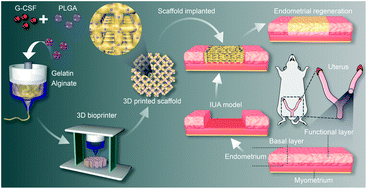3D-printed hydrogel scaffold-loaded granulocyte colony-stimulating factor sustained-release microspheres and their effect on endometrial regeneration
Abstract
After injury, the endometrium cannot self-repair or regenerate because damage to the uterine basal layer often leads to intrauterine adhesions (IUAs), which can cause serious problems such as infertility and recurrent miscarriage. At present, no clinically effective method is available for the treatment of IUAs. With its advantages of being individualized and precise, three-dimensional (3D) bioprinting technology has been used to regenerate various damaged tissues and organs. Granulate colony-stimulating factor (G-CSF) clearly plays a positive role in endometrial regeneration, but precise and individualized drug applications are a prerequisite for improving the therapeutic effect of G-CSF. This study utilized a 3D-printed hydrogel in combination with a sustained-release microsphere (SRM) system to prepare a 3D-printed G-CSF-SRM system (3D microsphere) in vitro. The system advantageously allowed the spatial control of drug distribution and structural individualization. In addition to being long-acting and having a sustained release, the 3D microspheres increased the local concentration of G-CSF. Using a Sprague–Dawley rat IUA model, we confirmed that the 3D microspheres promoted local endometrial regeneration, significantly suppressed endometrium tissue fibrosis, and improved endometrial cell (epithelial and stromal cell) and vascular regeneration. The 3D microspheres significantly improved the endometrial receptivity and restored the pregnancy function of the damaged endometrium. We believe that the 3D-printed G-CSF-SRM hydrogel scaffold design concept may be used to develop a more precise and individualized treatment method for the structural and functional repair of damaged endometrial tissues.



 Please wait while we load your content...
Please wait while we load your content...